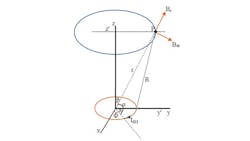The Department of Energy’s Oak Ridge National Laboratory (ORNL) power electronics team achieved the world’s first 20 kW wireless charging system for passenger cars by developing a unique architecture that includes an ORNL-built inverter, isolation transformer, vehicle-side electronics, and coupling technologies. For the demonstration, researchers integrated the single-converter system into an electric Toyota RAV4 equipped with an additional 10kW-hour battery (Fig. 1).
The researchers are already looking ahead to their next target of a 50kW wireless charger, which would match the power levels of commercially available plug-in quick chargers. Providing the same charging speed with the convenience of wireless charging could increase consumer acceptance of electric vehicles and is considered a key enabler for hands-free autonomous vehicles. As the researchers advance their systems to achieve higher power levels, one of their chief concerns is maintaining safety for the equipment and associated personnel.
Original work on wireless started about three years ago and was described in a paper presented by nine ORNL researchers in a 2013 IEEE Transportation Electrification Initiative (TEI) e-Newsletter. According to David Smith, vehicle systems program manager, “Wireless power transfer (WPT) represents a paradigm shift in electric-vehicle (EV) charging that offers the consumer an autonomous, safe, and convenient option to conductive charging and its attendant need for cables. Today’s technology is a stepping stone toward electrified roadways where vehicles could charge on the go.”
The 2013 newsletter said WPT can be fully autonomous due to the vehicle and grid-side radio communication systems, and is non-contacting; therefore, issues with leakage currents, ground faults, and touch potentials do not exist. It also eliminates the need for dealing with heavy, bulky, dirty cables and plugs. It eliminates the fear of forgetting to plug-in and running out of charge the following day and eliminates the tripping hazards in public parking lots and in highly populated areas such as malls, recreational areas, etc. Furthermore, the high-frequency magnetic fields employed in power transfer across a large air gap are focused and shielded, so that fringe fields (i.e., magnetic leakage fields) attenuate rapidly over a transition region to levels well below limits set by international standards for the public zone (which starts at the perimeter of the vehicle and includes the passenger cabin).
The ORNL approach to WPT charging places strong emphasis on radio communications in the power regulation feedback channel augmented with software control algorithms. The goal for this WPT is minimization of vehicle on-board complexity by keeping the secondary-side content confined to coil tuning, rectification, filtering, and interfacing to the regenerative energy-storage system (RESS). WPT charging represents the end game in the context of the connected vehicle, wireless communications, and eventually, with in-motion deployment of WPT, the ultimate in electric vehicle operation with unlimited range: dynamic wireless charging. ORNL is working toward more efficient coil designs, power electronics converter developments, and communications systems, as well as new control strategies in this field. ORNL WPT programs also define and address concerns related to personal safety and hazards that may arise. ORNL uses electromagnetic resonance inductive coupling system for wireless charging of electric vehicles.
ORNL is the lead organization for this activity and partners with Toyota Motor Corp., Evatran, Clemson University ICAR Center, Cisco, Duke Energy, and International Rectifier. With OEM, commercialization, communications, grid, and device partners, ORNL meets the aggressive power and efficiency goals for future’s electric vehicles with stationary and in-motion charging capabilities. At the end of the first phase, ORNL demonstrated 6.6kW and 10kW power transfer over 160mm gap with over ~>90% dc-to-dc efficiency, ~97% coil-to-coil efficiency, and 85% end-to-end (wall outlet to vehicle battery terminals) efficiency. The demonstration used dedicated short-range communication (DSRC) systems for vehicle-side data monitoring and feedbacks for controlling the grid side units.
Figure 2 is the block diagram of the original ORNL wireless power transfer system. The grid-side unit of the WPT system consists of an active front-end rectifier (AFER) with power factor correction (PFC), a high-frequency power inverter, a high-frequency isolation transformer, a tuning capacitor, and the primary coil. On the secondary (vehicle) side is the secondary coil in parallel with the tuning capacitor, a diode-bridge rectifier, and a filter capacitor.
Active Front-end Rectifier
Figure 3 shows the active front-end rectifier with power-factor correction. In the AFER converter, only the left leg of the active front-end rectifier is utilized and the right leg acts as a diode phase-leg. The AFER can work as a boost power factor correction circuit and is capable of boosting grid voltage’s peak value up to 10 times (normally 2-3 times).
The AFER with PFC can also be interleaved for higher power rating. For high efficiency, low loss, and high switching frequency and reduced current ripple, it uses APT100MC120JCU2 SiC MOSFET phase-leg modules. The converter is operated based on the reference power to be delivered to the vehicle battery. Basically, depending on the battery reference current, a PI (proportional integral) controller is used to determine the reference current magnitude from the grid. A phase-locked-loop (PLL) system determines the grid voltage phase angle and the grid reference current is shaped accordingly. An outer PI controller uses the actual grid current and the internally generated reference AC current and determines the switching states. With the selected architecture, ORNL achieved a power factor of >98% and current total harmonic distortions (THDI) of <5%. In addition, because the AFER regulates the primary side DC link voltage, the battery current ripple is reduced to <10 A.
Coupling Coil Design
Electromagnetic design of WPT coupling coils provides the most fundamental investigation into their performance. At ORNL the WPT team developed couplers based on the magnetic vector potential at a field point due to current flowing in an ideal primary coil conductor. The potential at this field point is defined to lie at the location of the secondary coil. For a coil pair of radius a, assuming infinitesimal conductor radius, and having a coil to coil spacing z, then the radius vector from the primary coil origin to the field point becomes:
The corresponding vector potential, Aφ, for the case of N1 primary turns and I1 A yield a primary excitation of N1I1 amp-turns (Fig. 4).
At the field point P, the magnetic vector potential is strongly dependent on primary coil radius, total current, the co-elevation angle θ, and inverse with the square of the separation distance, r. However, it is the flux density B(r, θ), and total flux Φ at the secondary coil that is most relevant to WPT performance and is given as:
High Frequency Inverter
Load conditions; i.e., state-of-charge of the battery and coupling coefficient; i.e., vehicle coil to primary pad gap and any misalignment between transmit and receive coils determine the frequency response of the WPT system. The amount of power transferred to the secondary coil is governed by the switching frequency, duty cycle, and the input voltage of the inverter. This relationship can be expressed as:
Where:
Ud0 = HF power inverter rail voltage
d = pulse duty ratio
w = angular frequency
Although the primary coil voltage can be controlled by the active front end converter to vary the dc rail voltage Ud0, the ultimate objective is to dynamically change the switching frequency and the duty cycle in order to achieve the best operating conditions in terms of efficiency and power transfer. In the ORNL laboratory setting, the HF power inverter voltage was adjusted using a power supply. In a commercialized version of this WPT technology a dedicated short range communication (DSRC) link as shown in Fig. 2 would be needed. The transmitter side of the DSRC collects the measurement data such as battery voltage, battery current, and battery management system (BMS) messages needed for regulation. The grid-side receiver side of the DSRC channel receives this information for control purposes along with supporting primary side measurements. Then, a DSP based embedded control system determines the switching frequency and the appropriate duty cycle according to the control law being used. The switching signals for the inverter IGBTs are generated by the DSP control algorithm and applied to the HF power inverter gate drives. The control system can also regulate the inverter power based on the reference power commands that can be received through the V2I communications from a smart grid compliant utility.
(Portions of this article were prepared by the Oak Ridge National Laboratory, operated by the UT-Battelle for the U.S. Department of Energy under contract DE-AC05-00OR22725. Accordingly, the U.S. Government retains a non-exclusive, royalty-free, license to publish from the contribution, or allow others to do so, for U.S. Government purposes. The research team included Omer C. Onar, Steven Campbell, Cliff White, Larry Seiber, Chester Coomer, Lixin Tang, Paul Chambon, Madhu Chinthavali, and John M. Miller.)
Looking for parts? Go to SourceESB.






